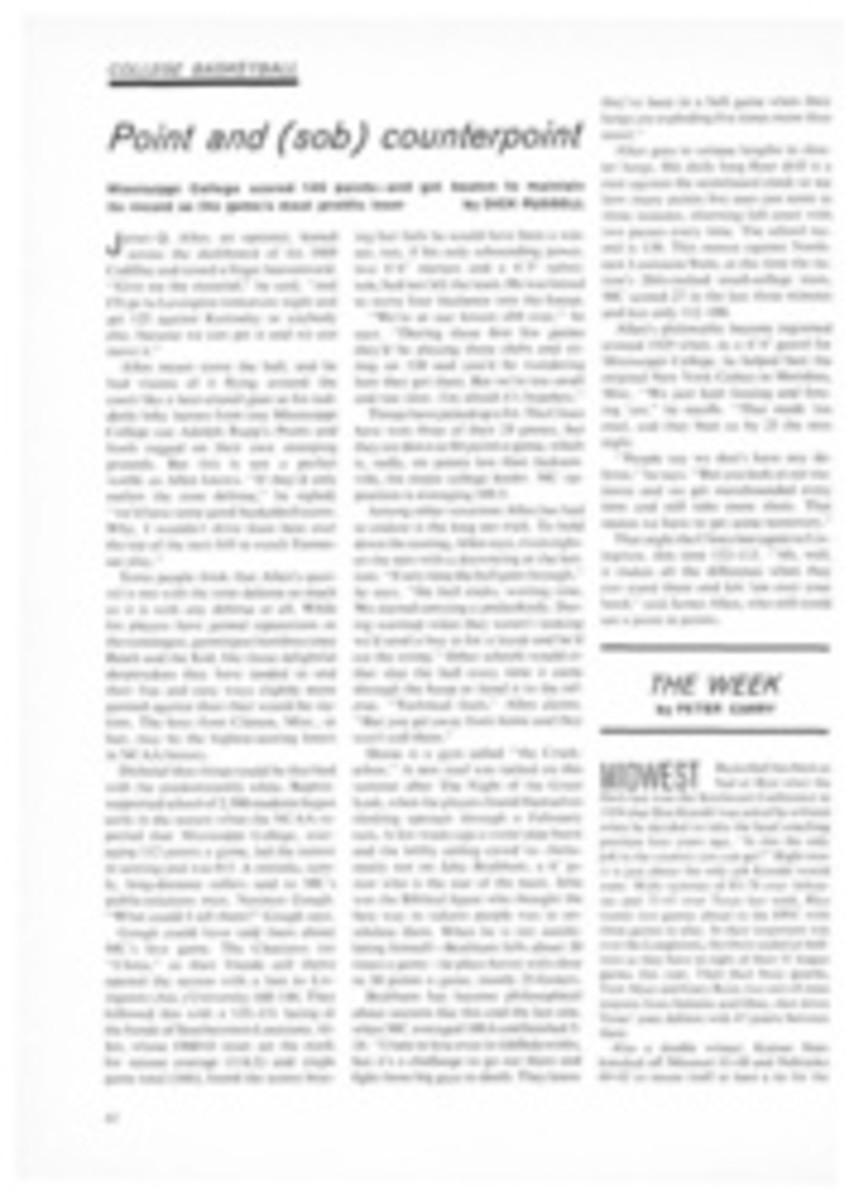
All this and rainbows, too
A finicky fly-fisherman given to Leonard rods and Hardy reels, not to mention the ultimate refinement of lines, leaders and lures attendant upon that sport, can easily run up a four-figure bill in an afternoon at Abercrombie & Fitch's. The trout purist, after all, is the most discriminating of anglers. He is concerned less with catching fish than with how they are caught, and he will spare no expense to properly perform his art. The fulcrum of any fishing department, he is as recognizable by his conservative dress and distinguished manner as is the Texas cat fisherman by his five-gallon hat and cowboy boots.
At least that is the way it used to be. But lately Texans have become the big spenders at fly-fishing counters, a fact that prompted one salesman to ask if the buyer were planning a trip to Ireland. "Hell, no!" the Texan bellowed. "This is for home, boy, back home in Texas."
Trout? In Texas? Well, as a matter of fact, yes. Not only are they genuine rainbow trout, but they are found in some of the prettiest trout water anywhere. More improbable still, the trout and the water are producing a breed of fly-fisherman who may well prove to be the purest of them all.
Texas streams traditionally have been too warm for such cold-climate fish as trout, which prefer water temperature between 45° and 70°. The state's 4,000 rivers, streams, creeks and bayous are filled with bass, carp, suckers, eels, sunfish, crappies, bluegills, catfish—all simple, hardy, familiar fishes that require no special gear to catch. With such a surfeit of meat fish around, who missed trout?
The answer is almost nobody except a fisheries biologist named Richard L. White and a San Antonio brewer named Harry Jersig. White, Jersig and trout were brought together four years ago by Canyon Dam on the Guadalupe River between San Antonio and Austin. Before the dam was completed in 1964, annual rises of 40 and 50 feet were common in this area. Because of such flooding, no industry, farming or wildlife could survive.
White, stationed then at the Texas Parks & Wildlife State Hatchery in San Marcos, headed a project studying the fishery potential of the area. By the time ground was broken for the dam, his group of bright young biologists and wildlife specialists had produced a roomful of reports. One of these studies suggested that trout might be able to live in the waters below the dam.
"Nobody took the idea seriously at first," White recalls. "It was more a case of covering every possibility. But as the dam and the research grew, the idea of trout became more and more intriguing."
The two prime requisites of rainbow trout are cold water and sufficient oxygen. The extreme depth of the lake formed by the dam indicated that bottom temperatures would run about 58°. This meant that water released into the Guadalupe River would be, for about a nine-mile stretch, of temperatures compatible with trout survival and growth. White was convinced that the nine miles of Guadalupe River below the dam could be transformed into the country's most southerly trout stream.
"In my enthusiasm I overlooked one thing," White says. "The trout. I had the water but no fish, and that was no small problem. This is bass country down here, and you don't spend a bass fisherman's taxes on trout. Not if you want to stay in Texas, anyway."
Thanks to Harry Jersig, Dick White is still in Texas and there are plenty of trout in the Guadalupe River. Jersig, as a member of the Texas Parks & Wildlife Commission, had been following Dick White's project from its beginnings. He was also an old hand at transforming the most unlikely bodies of water into trout pools. For several years, as a promotion for his Lone Star Brewery, he had been dispatching tanks (the largest 12 by 60 feet with a capacity of 5,760 gallons) full of trout to charity bazaars and local fairs around the state.
Operation X-bow, as Jersig named the Guadalupe trout experiment, was made to order for Lone Star. Its former motto, "We make the most of nature's best," extends beyond malt and hops into all phases of conservation. South of San Antonio, Lone Star has 30,300 acres of land in experimental game-management and brush-control programs, the results of which directly aid Texas Parks & Wildlife research. The brewery itself is a monument to hunting and fishing and a regular stop on San Antonio sight-seeing tours. Its cypress-paneled Hall of Fins contains more than 70 mounted specimens of marine life, ranging from palm-sized piranha to a 1,056-pound black marlin. The Hall of Horns, in addition to being a remarkable collection of large and small game from around the world, contains, full-mounted, the world's record Texas longhorn (horn spread: 8 feet 9 inches), a 78-point white-tailed non-typical deer head that was taken near Brady, Texas in 1892 and a collection of more than 2,000 pairs of deer antlers which festoon the ceiling in stalactitic splendor.
Over the years Jersig has collected almost as much knowledge about wildlife as trophies of it. His knowledge of rainbow trout prior to Operation X-bow spanned 10 years of research with a trout hatchery in Missouri. Jersig was as convinced as White that the rainbows not only could survive but thrive on the Guadalupe.
In April 1966 Jersig and White released 10,000 12- to 14-inch rainbows into the swirling currents of the Guadalupe below Canyon Dam. While White and Jersig grinned for photographers, local anglers gathered on the riverbank. They were armed, as for most Texas angling, with worms, plugs, spoons and an assortment of tackle heavy enough to beach a tuna. The young pen-raised trout, ravenous after the trip from Missouri, were pulled out of the water almost as fast as they were put in.
"We learned a few things on that first drop," says Jersig. "First, if we did not feed the fish until they were full just before stocking, they could be caught on anything from a beer-can opener to a piece of bubble gum. The first day is critical. After that they get smart. We also discovered that eight-inch fish did better from an economic standpoint than the larger ones we originally stocked. The fish we stock now average four to five ounces and grow at the rate of one-quarter of an inch a month. One was caught in 1968 that weighed 4 pounds 12 ounces. Obviously, they are thriving."
Since the first drop in 1966, Lone Star has put more than 35,000 trout in the Guadalupe River. "The brewery provided most of the money," says White, "but the beautiful thing is that they let us handle the program entirely."
White's tagging and fin-clipping studies since 1966 indicate that most of the trout do stay within the nine-mile stretch south of the dam. Since water temperatures, which average from 58° to 62°, do not fall off abruptly at one specific point, a few wander beyond, and random trout have been taken as far as 25 miles below the dam. But these are exceptions. The harvest rate of 50% within three to four months of stocking is strong evidence that the majority stay where they are put.
Such high harvest is ample proof, too, of Operation X-bow's success. There is no question that the trout are doing even better than anticipated, although to date there has been no indication that they are reproducing.
"This is not as dire as it sounds," White points out. "Very few trout fisheries in the U.S. are self-sustaining in terms of reproduction carrying the stream's potential of fish. In 1969 Colorado spent $1‚Öì million doing exactly what we are doing here—providing put-and-take fishing. At this point, we are not really concerned with reproduction. What we care most about is providing anglers with attractive, interesting fishing.
"Before the dam," White explains, "the fishery in this whole area was dead. At the most liberal guess, this 10- to 15-mile stretch of stream provided maybe 500 man-hours of fishing a year. Today the same water produces 25,000 man-hours of sport in the same period. We have taken a dead area, revived it and transformed it into one of the most unique fisheries in the U.S."
It is also one of the prettiest. Giant cypress trees rise above the banks, their roots gnarled and twisted. The water, clear and pollution-free, tumbles over limestone flats and rocky falls, swirling into frothy eddies. The surrounding country is pastoral and sparsely settled, unchanged physically by its new-found fame.
Even so, the economic impact on the area has been enormous. Where there was once little to attract anyone into the region, anglers now come from all over the state. There is no closed season, and creel limits are five trout. Regular angling groups drive down from Houston and Dallas some weekends, and day fishermen out of San Antonio and Austin keep cash registers ringing in Canyon City and nearby towns.
But the most dramatic change has occurred in the anglers themselves. "You should have seen the outfits they showed up with at first—even surfcasting gear," White recalls. "But then some of the northern transplants who live or are stationed near here came out, and they were something else again. They had those hats with the flies stuck in them, little trout vests, dip nets, wicker creels and all kinds of stuff we used to see only in catalogs."
The reaction of local anglers was a combination of astonishment and amusement. When the Yankees strapped cleats onto their waders, the natives snickered. When they waded out into the fast-moving water, there was loud laughter. But when the Northerners began catching fish, a sudden silence fell on the spectators. Texas habits die hard, but none is immortal. The locals could not ignore the fact that the fly-fishermen were catching fish when they were not.
Soon fly rods were being whipped up and down the Guadalupe by the natives. Former meat fishermen now speak of "the poetry of angling," while others debate the relative merits of Royal Coachmen and Parmachene Belles. Words such as Plecoptera, Trichoptera, caddis and nymph slide easily off Texas tongues these days, and such books as The Complete Fly Fisherman, Matching the Hatch and All About Trout are turning up in more and more ranch libraries. In San Antonio there is even a newly formed chapter of Trout Unlimited.
"Who ever would have believed that could happen in Texas?" says Dick White. Fortunately for Texas, he and Harry Jersig believed.
PHOTO
HARRY JERSIG WITH A RAINBOW TRIO
PHOTO
JERSIG CASTING ON THE GUADALUPE

